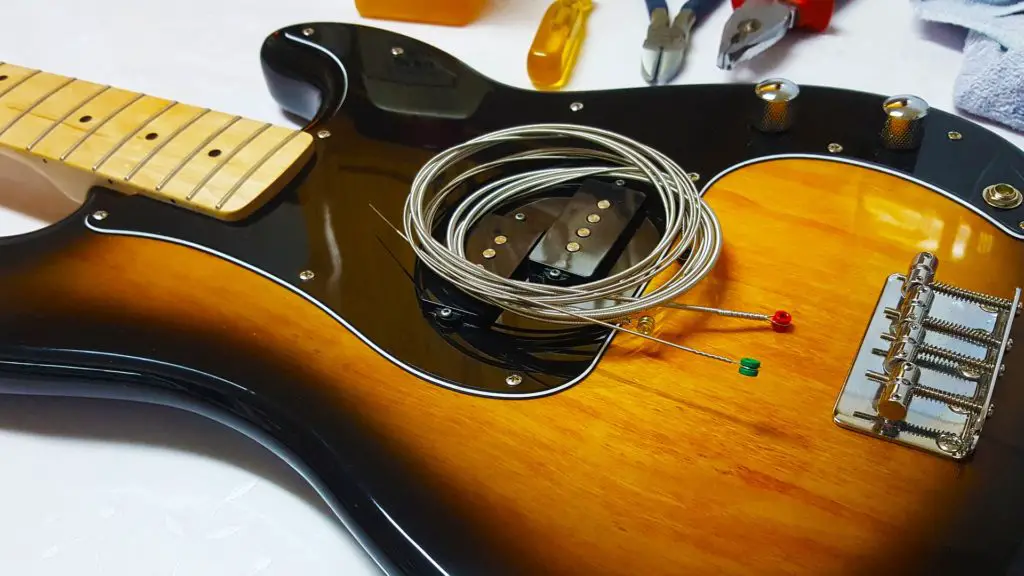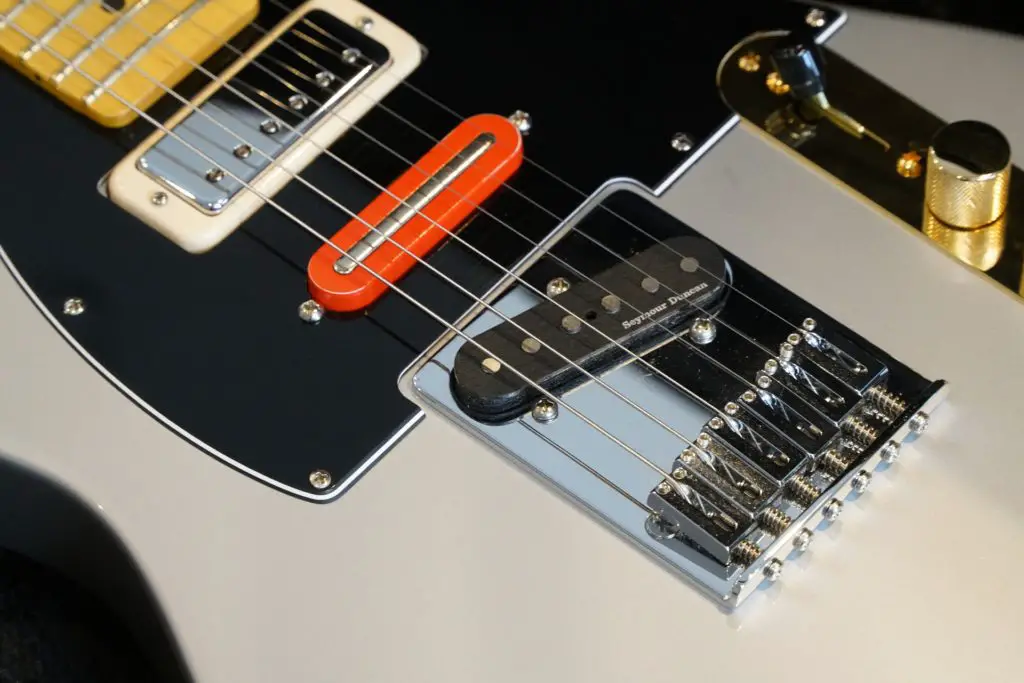Do you know that your pickups can affect not just the sound of your guitar but its playability and durability as well?
Guitar pickups are one of the most important components of your axe. It is an electronic device that captures string vibrations via magnets attached to its metal core surrounded by wire coils.
However, many guitarists don’t give them a second thought. They just plug in and go with whatever sounds good to their ears.
So, what are guitar pickups? What are the different types, how to install them correctly, and the difference between passive vs. active pickups?
Let’s go over what they are and how they work so you’ll know more about this key piece of gear!
Quick Links
What is a Guitar Pickup?
Guitar Picks are electromagnetic transducers operating at the speed of sound that senses the pick’s movement and transmit it to an amplifier or recording interface.
The strings cause electromagnetic changes in proximity to the pickup, creating a varying current through its windings representing variable electrical voltages.
These signals can then be mixed with other signals coming from various sources to produce sound waves.
Why use Guitar Pickups?
There are various advantages to using a pickup to amplify your sound. With this amazing equipment, you can reap the following benefits:
Improves The Quality of Sound
The pickups can convert the vibrations into different sound waves, which are then amplified. It enhances the quality of your sound, making it richer and much more powerful.
Diversity
Guitar pickups can help you play different styles of music without lots of adjustments. You don’t have to switch guitars or make any changes – just a simple twist can change your sound from one genre to another.
Additionally, it has a wide range, something that other musical instruments cannot offer.
Great Accessories
Pickups also come with attachments that you can use for different effects and experiments on your guitar’s sound, which will enhance its overall ability as an instrument.
Just be sure to do this safely and avoid damaging the instrument’s mechanics as much as possible, especially when changing these accessories.
In addition, Guitar pickups are now made from more substantial materials, so they will last longer and won’t easily break even if they are dropped or mishandled.
What is the Difference Between Passive and Active Pickups?
Pickups are divided into two categories: passive and active. These two will produce a completely different set of effects on your electric guitar’s sound and will alter its overall capabilities by a great deal.
Let’s define these two for you to understand more clearly.
Passive Pickup
A passive pickup is not powered, meaning it does not have any built-in preamplifier or output jack.
The tone and volume of its pickups are operated by the tone and volume knobs, which are connected through a piece of copper wire that transfers signals from one end to another with no extra equipment needed.
This makes passive pickups the cheapest type among the two, but this also means you will need separate effect units just to get your desired sound.
However, there are also disadvantages when using passive pickups. One is that high volumes tend to produce some form of interference that can affect the clarity of the sound.
Another disadvantage is that its output level cannot produce a strong enough signal for some amps, primarily through long wire lengths. The solution to this problem is getting a preamp pedal that will boost your passive pickups’ signal strength.
Active Pickup
With active pickups, one side is a metal wire, and the other side is often magnetic – and both sides face each other so that they can send an electric signal down the two wires.
The magnetic guitar generates electricity transmitted onward by electromagnetic induction straight into your amp. You control it with volume, tone, and effects pedals like any other guitar effect rig!
Active pickups must be plugged into a power source, usually a battery on the guitar or phantom power. They tend to be hotter and louder than passive pickups, with less low-end loss due to long wire lengths.

The Different Types of Guitar Pickups
Let us dig a bit deeper and get to know the different types of guitar pickups. We will cover each one separately and check out what exactly they are capable of.
Single Coil
This is the most common type of pickup that’s used on nearly all electric guitars and basses. It uses a single magnet, and it has two coils, one for the neck pickup and another for the bridge pickup.
There are no phase issues because both these parts receive an even signal from either coil, making for a brighter, crisper sound. Single coil pickups are also more susceptible to picking up external interference and electric fields.
Humbucker
This works similarly to a Single Coil, except that it doesn’t have any hum problems because of its internal design. They usually come in the form of two coils that are wrapped around the poles of a magnet.
So each coil works against another to eliminate any hums, which is an advantage over single-coil pickups.
Humbuckers have their own set of problems, though. The main problem is that they sound darker than single-coil pickups, and it’s hard to get them to generate many high frequencies because of their design.
P90
It is a single-coil pickup, but instead of having its own set of pole pieces wrapped around the magnet, it uses a metal casing to enclose its coil.
So the bigger size of a P90 essentially means that it can have a thicker tone which is why some people prefer this over a standard single-coil design.
Another thing about this type of design is that it has no hum problems and more output than your average single-coils.
Split Coil
This type of pickup consists of two coils. But one side is placed above the other instead of being coiled together. So, you can access both with a simple switch without having to split or remove any pickup covers.
This way, you can enjoy all the benefits associated with Humbuckers along with Single Coil sounds.
Dual Coil
This type of guitar pickups are humbuckers, although they are less prevalent than split-coil pickups. This type of pickup offers a richer tone compared to single-coil. The dual coil is excellent if you want a more classic bass tone, but they don’t have the same level of clarity as the other guitar pickups.
Piezo Pickups
These pickups are not as popular as the other ones mentioned above, but they’re certainly worth mentioning as well. They use an actual amplified crystal instead of magnets to produce sound, making them what you call “Electrostatic” pickups.
Because of this, they can have problems producing feedback or picking up background noises. That is why acoustic guitar players mostly use them, so they can play them without dealing with any issues.
Soap Bar
These are the most popular guitar pickups on the market. They’re usually used in either neck or bridge positions, and they produce a more powerful sound with plenty of mid-range, making them perfect for your average rock tone.
All of these guitar pickups have their own unique sound and design, so it’s up to you to experiment with them to see which one would be best for you.

How to Choose the Right Guitar Pickup
One of your primary concerns is finding the right pickups to fit your style and sound as a guitar player. But, it doesn’t have to be. To narrow down your choices, here are a few basic guidelines you should keep in mind when shopping for pickups:
Determine Your Sound
Are you looking to get more of a “classic” sound? Or one that is warm and smooth with plenty of mid-range? Or are you looking to go for something different? If so, try moving towards some single-coil models or even some active ones.
Once you identify the type of tone you’re going for, it becomes much easier to find a pickup that will suit your needs.
Determine Your Style
Aside from sound, it would be best if you also determined your playing style. Do you love some understated tones that will give you more of an acoustic-like sound? Or do you want to crank it up and go for something with a bit more aggression?
Guitar pickups are made differently to produce different sounds, so it’s best to have an idea of the style you like before you start shopping.
Quality and Durability
When determining your pickups, do not overlook their build quality. This means the harness, the cable, and just about everything else. All these things can lead to problems if not done right.
Additionally, quality is equivalent to durability. So make sure you do not get something too cheap because while cheaper means less money, it also means replacing the pickups more often.
Output Level
Most pickups in a similar style will often have a bit of variance regarding output level. Some might produce hotter signals than others, which affects the overall tone that you get from them.
If you are playing with higher gain, having an extra hot signal can help to give more sustain and saturation for aggressive sounds. But if you’re going for something mellower, these can detract from your tone and make things sound less clear.
Material
As we’ve mentioned, the material used in constructing certain pickups does affect how they’ll sound – even if they produce similar output levels.
So take elements like the magnets used and what type of wire is being utilized into consideration here – especially if they’re exposed to a lot of water or humidity regularly.
Diameter
This is going to affect the way that your pickups look and feel on your bass. The diameter will tell you how thick each string will be, so it’ll let you know how likely you are to achieve any clear bends when playing notes on those strings.
It’s also worth taking into consideration that thicker strings will typically produce more punchy sounds too. They have a more significant amount of mass than thinner strings, which can sometimes sound a little bit ‘limp’.
As for how large your pickups measure out, there are no set criteria here. But the larger they are, the more powerful they’ll tend to be – meaning that they’ll be able to capture a larger string vibration and reproduce it with a slightly different tonal quality.
String Gauge
The string gauge will also affect your bass’s playability, so it’ll be worth considering what you want from your instrument before purchasing new pickups for it.
If you’re not sure whether or not you can get used to playing on certain gauges, it might be worth testing them out on an old instrument that you can sacrifice if need be.
Now that you know some key things to look out for before making any buying decisions. Let’s proceed with the best guitar pickups available on the market today.
Products We Recommend
Check out these top-rated guitar pickups on Amazon below:
1. Fishman Neo D Single Coil Magnetic Soundhole Pickup
Fishman Neo D Single Coil Magnetic Soundhole Pickup
Looking for a low-cost soundhole pickup that delivers top-notch sound? The Fishman Neo D pickup is an excellent choice for any budget-conscious musician.
It’s a single coil magnetic soundhole guitar pickup, which makes it easy to install and universally compatible with most guitars without the need for any modifications.
The unit itself feels sturdy and well-constructed, so it should last you many years if properly cared for. Plus, when installed correctly, it won’t produce any unwanted noise or hum when in use.
2. KNA NG-1 Piezo Pickup for Nylon String Guitar
KNA NG-1 Piezo Pickup for Nylon String Guitar
This guitar pickup is designed to be small and compact, so it won’t interfere with your playing or alter the look of your instrument in any way. Plus, it will fit all standard 1/2″ diameter soundholes without the need for any tools or modifications.
The design will ensure that you’ll never have to install any batteries or worry about power drainage on your guitar. It also has a detachable cable for easy installation.
With this model, you’ll get a natural, true tone from your nylon-string guitar. You can never go wrong with the choice of having this durable, high-quality product for your guitar.
3. Seymour Duncan Woody HC Hum-Canceling Soundhole Pickup
Seymour Duncan Woody HC Hum-Canceling Soundhole Pickup
This is another soundhole pickup that any player should invest in. It’s made of wood by Seymour Duncan, which means you’ll get the best quality for your money.
Woody HC Hum is a passive, noise-free soundhole pickup that produces a rich, warm acoustic timbre suitable for a wide range of acoustic instruments. The single-coil variant has a fuller, more compressed sound due to its hum-canceling construction.
With this pickup, you’ll get rid of having to deal with any concerns about keeping it charged or drained out due to extensive use. You can rest assured that there’s no need for gadgetry when using this high-performance product.
How to Install Your New Guitar Pickup
The installation process is pretty easy and quick, so you don’t have to worry about taking longer than expected to get everything done.
Just follow the steps below:
1. Remove the Back Cover of Your Guitar
This is where you’ll find the pre-existing pickup. Look for the model number inside your instrument; this will help you when buying a pickup replacement kit because not all kits are compatible with certain models.
2. Detach the Pickup
The most common place they are located is under the metal tab that covers the strings, which will be relatively easy for you to access. If there’s no metal tab covering the string lock, then look at the pickups.
Once you find them, ensure to remove all the necessary wires connected to it for you to take it out of its position without any problem. This way, you’ll get a clearer view of where exactly you can place it back once you attach your new guitar pickup.
3. Place the Guitar Pickup in Its Right Spot
Get this done by careful positioning so that everything will fit accordingly with each other and align properly. Please make sure not to mount it too high or too low since doing so could pose serious difficulties when playing your instrument.
You might also want to check if the height feels okay by looking at how high or low the strings are. Remember that you have to pick a spot where it can produce its best sound while being in perfect contact with your guitar’s strings.
4. Securely Tighten the Screws
If all has been done correctly, there should be no way for your new guitar pickup to easily fall off from its position after properly tightening all of the necessary hardware components. Make sure not to leave anything loose since doing so could cause potential problems along the way.
A good rule of thumb is to tighten every screw on and around three times each one just to make sure that nothing will ever come loose or hold too tightly without compromising quality at some point.
Moreover, if your screws were set too tight, they would require more than just a simple screwdriver because it may also need pliers for this process.
5. Connect Everything Together
Attach your two wires between your hot lead wire and ground wire to your guitars’ volume and tone knobs.
Use a pair of tweezers or needle-nose pliers to help you with this part if necessary. But make sure not to hold these fixtures too tightly since they can bend and warp over time.
Also, connect your battery clip’s negative lead wire into the ground point on your guitar.
6. Test Out Your Guitar
After you have made all of the necessary connections, turn on your guitar amp and test out different volume levels and your tone settings.
Check for any background noise that could be produced from loose connections between hardware components such as wires and screws.
Make adjustments accordingly until nothing is heard at all during testing procedures. Sometimes it takes tries doing things like this before you can get a feel for what to expect in your final product.
Important Tips
- All connections must be good before soldering anything, so test it first with a 9volt battery.
- Once everything is good, solder wires to one end of your output jack and make sure that they are appropriately connected before soldering them together.
- Be careful, though, because these things can get hot when using the soldering iron too much!
- Make sure that there’s no rust on your old pickups because it could cause problems if this happens. So make sure that all components are dry and free from rust before setting up new ones.

Some Final Words
Pickups are an integral part of the sound from your guitar. They can add or remove a tremendous amount of character from your tone. So, it would be best that you’d know what you’re dealing with.
Understanding the basics of what makes up a pickup is important, how they work, and why they sound the way they do.
It will help you grasp how to set up your guitar/gear for optimum performance, especially if you are recording or playing live.
So, get your new pickup installed, or wire up that switch and see how it changes your tone.
The sky’s the limit; there’s a lot you can do with pickups, and hopefully, this guide will help you get started on your journey to tone-heaven. Enjoy playing!




